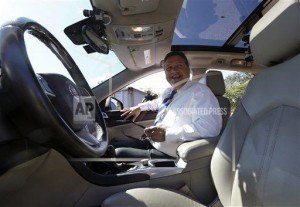Premiums for U.S. auto insurers may drop more than 40 percent once the use of automated vehicles has been fully adopted by 2050 and driving becomes safer, according to insurance broker Aon Plc.
“We as an industry need to act quickly to ensure that we have the products available to align to the new paradigm,” Paul Mang, head of analytics at Aon, said at a press conference in Monte Carlo on Sunday. “Autonomous driving clearly moves the business mix to fleet products and commercial lines.”
 Insurers such as Allianz SE and Munich Re are trying to assess the impact of automation on their biggest non-life insurance market as carmakers from Tesla Motors Inc. to Daimler AG and Volvo AB embrace the technology. Personal auto insurance accounts for 47 percent of global premiums, according to Aon .
Insurers such as Allianz SE and Munich Re are trying to assess the impact of automation on their biggest non-life insurance market as carmakers from Tesla Motors Inc. to Daimler AG and Volvo AB embrace the technology. Personal auto insurance accounts for 47 percent of global premiums, according to Aon .
U.S. motor premiums could drop 20 percent from last year’s level by 2035, the broker said. In Europe, motor insurance is the main non-life insurance business line with annual premium income of about 120 billion euros ($135 billion), according to data by Insurance Europe.
While premiums drop as automation makes driving safer, there will be new risks, according to Stefan Schulz, global head of motor and property consulting at Munich Re, the world’s biggest reinsurer. He predicts premiums will fall 25 percent by 2030.
“The new technology will improve a lot of things but it will also bring new risks such as hacker attacks on connected cars and rear-end collision of trucks driving in automated convoys,” Schulz said. “It’s still a long way before vehicles are fully autonomous on our roads.”
Was this article valuable?
Here are more articles you may enjoy.

 State Farm Sued Over Policies Backed by Distressed Insurer PHL
State Farm Sued Over Policies Backed by Distressed Insurer PHL  Losses Top $20 Billion in Asia Floods as Climate Risks Grow
Losses Top $20 Billion in Asia Floods as Climate Risks Grow  How Three New CMS Policies Impact Workers’ Comp Claims
How Three New CMS Policies Impact Workers’ Comp Claims  Asahi Sales Drop Worsens as Cyber Hack Disruption Lingers
Asahi Sales Drop Worsens as Cyber Hack Disruption Lingers 